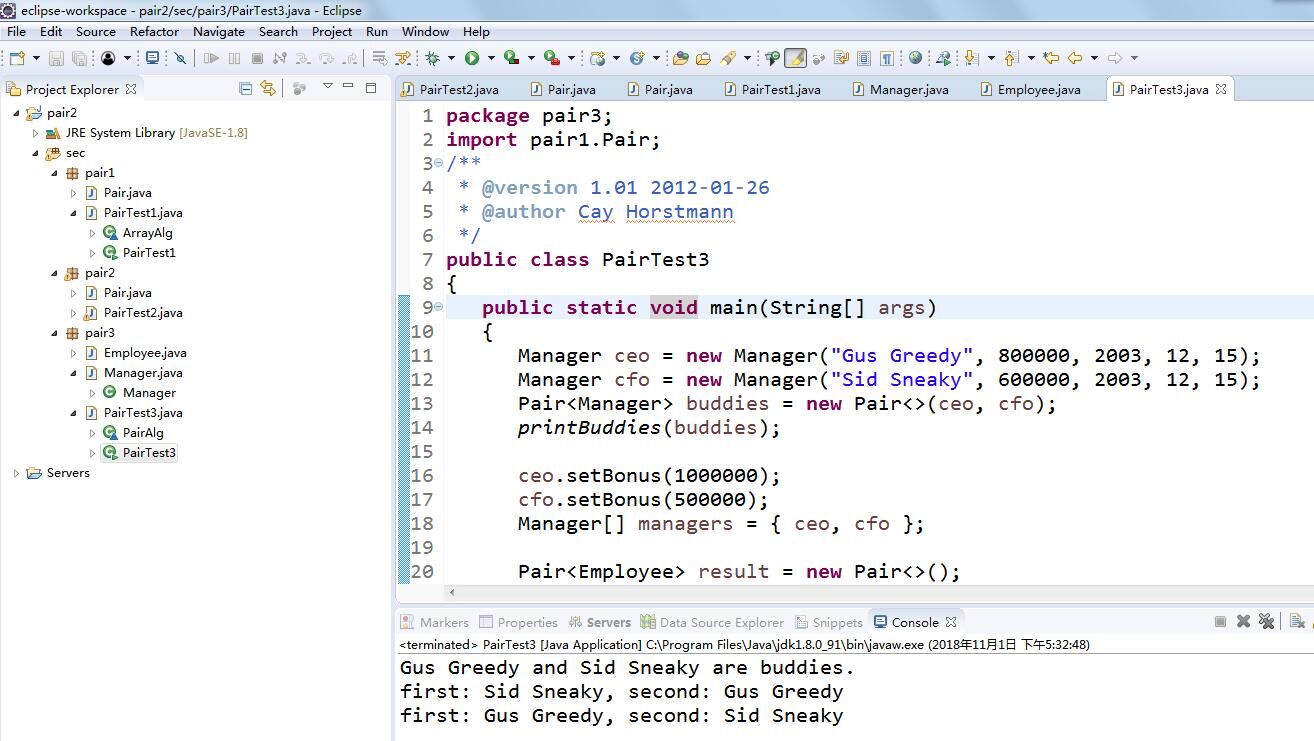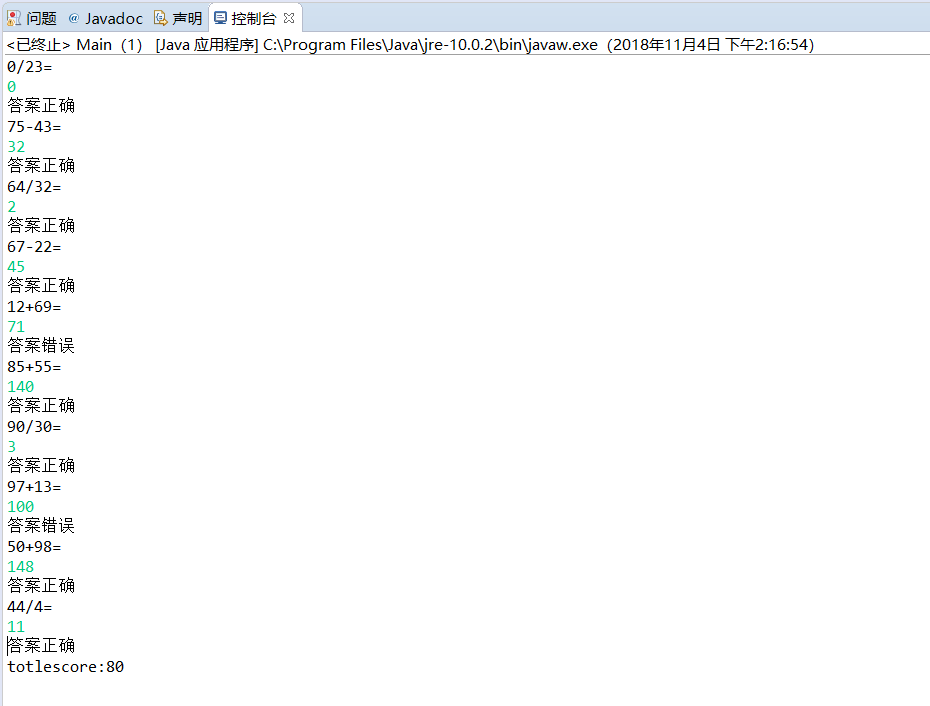201771010108 -韓臘梅-第十週學習總結
第十週總結
一、知識總結
1.定義簡單泛型類
1.1一個泛型類Generic class就是具有一個或多個型別變數的類
1.2Java中,使用E表示集合的元素型別,K和V表示Map的關鍵字和值的型別。T(需要時還可以使用臨近的U和S)表示“任意型別”。
1.3泛型類可以看作普通類的工廠
2.泛型方法
2.1型別變數放在修飾符的後面,返回型別的前面。泛型方法可以定義在普通類中,也可以定義在泛型類中。
2.2當呼叫一個方法時,在方法名前的尖括號中放入具體的型別。
3.型別變數的限定
3.1<T extends BoundingType>表示T應該是繫結型別的子型別subtype,T和繫結型別可以是類,也可以是介面。一個型別變數或萬用字元可以有多個限定(用&)
3.2如果用一個類作為限定,它必須是限定列表中的第一個。
4.泛型程式碼和虛擬機器
4.1無論何時定義一個泛型型別,都自動提供了一個相應的原始型別raw type。原始型別的名字就是刪去型別引數後的泛型型別名。擦除erased型別變數,並替換為限定型別(無限定的變數用Object)
4.2為了提高效率,應該將標籤tagging介面(即沒有方法的介面)放在邊界列表的末尾。
4.3橋方法bridge method
4.4具有協變的返回型別covariant return types
4.5記住有關泛型轉換的事實:1.虛擬機器中沒有泛型,只有普通的類和方法;2.所有的型別引數都用它們的限定型別替換;3.橋方法被合成來保持多型;4.為保持型別安全性,必要時插入強制型別轉換。
5.約束與侷限性
5.1不能用基本型別例項化型別引數
5.2執行時型別查詢只適用於原始型別
5.3不能建立引數化型別的陣列
5.4Varargs警告:使用@SafeVarargs
5.5不能例項化型別變數
5.6不能構造泛型陣列
5.7泛型類的靜態上下文中型別變數無效
5.8不能丟擲或捕獲泛型類的例項
5.9可以消除對受查異常的檢查
5.10注意擦除後的衝突
6.泛型型別的繼承規則
6.1泛型類不是斜變的
7.萬用字元型別
7.1萬用字元型別中,允許型別引數變化。如Class<? extends SuperClass>表示任何泛型Class型別,它的型別引數是SuperClass的子類,如Class<subClass>
7.2超型別限定supertype bound:? super subClass 這個萬用字元限制為subClass的所有超型別。可以為方法提供引數,但不能使用返回值。
7.3無限定萬用字元 :Class<?> 和Class本質的不同在於:可以用任意的Object物件呼叫原始class的setObject方法
二、實驗:泛型程式設計技術
1、實驗目的與要求
(1) 理解泛型概念;
(2) 掌握泛型類的定義與使用;
(3) 掌握泛型方法的宣告與使用;
(4) 掌握泛型介面的定義與實現;
(5)瞭解泛型程式設計,理解其用途。
2、實驗內容和步驟
實驗1: 匯入第8章示例程式,測試程式並進行程式碼註釋。
測試程式1:
l 編輯、除錯、執行教材311、312頁 程式碼,結合程式執行結果理解程式;
l 在泛型類定義及使用程式碼處添加註釋;
l 掌握泛型類的定義及使用。
程式碼:
package pair1; /** * @version 1.00 2004-05-10 * @author Cay Horstmann */ public class Pair<T> //Pair類引入了一個型別變數T,用尖括號括起來 { private T first; private T second; //指方法的返回型別以及域和區域性變數的型別 public Pair() { first = null; second = null; } public Pair(T first, T second) { this.first = first; this.second = second; } public T getFirst() { return first; } public T getSecond() { return second; } public void setFirst(T newValue) { first = newValue; } public void setSecond(T newValue) { second = newValue; } }
package pair1; /** * @version 1.01 2012-01-26 * @author Cay Horstmann */ public class PairTest1 { public static void main(String[] args) { String[] words = { "Mary", "had", "a", "little", "lamb" }; //ArrayAlg呼叫靜態方法minmax(); Pair<String> mm = ArrayAlg.minmax(words); System.out.println("min = " + mm.getFirst()); System.out.println("max = " + mm.getSecond()); } } class ArrayAlg { /** * Gets the minimum and maximum of an array of strings. * @param a an array of strings * @return a pair with the min and max value, or null if a is null or empty */ public static Pair<String> minmax(String[] a)//定義靜態泛型方法,將型別變數例項化為String; { if (a == null || a.length == 0) return null;//a.length是陣列的屬性值; String min = a[0]; String max = a[0]; for (int i = 1; i < a.length; i++) { if (min.compareTo(a[i]) > 0) min = a[i]; if (max.compareTo(a[i]) < 0) max = a[i]; } return new Pair<>(min, max);//呼叫泛型類物件,返回一個例項化後的類物件; } }
結果:

測試程式2:
l 編輯、除錯執行教材315頁 PairTest2,結合程式執行結果理解程式;
l 在泛型程式設計程式碼處新增相關注釋;
l 掌握泛型方法、泛型變數限定的定義及用途。
程式碼:
package pair2; /** * @version 1.00 2004-05-10 * @author Cay Horstmann */ public class Pair<T> { private T first; private T second; public Pair() { first = null; second = null; } public Pair(T first, T second) { this.first = first; this.second = second; } public T getFirst() { return first; } public T getSecond() { return second; } public void setFirst(T newValue) { first = newValue; } public void setSecond(T newValue) { second = newValue; } }
package pair2; //import PairTest1.Pair; import java.time.*; /** * @version 1.02 2015-06-21 * @author Cay Horstmann */ public class PairTest2 { public static void main(String[] args) { LocalDate[] birthdays = { //按ASCII碼比較,大寫字母比小寫字母的ASCII碼小; LocalDate.of(1906, 12, 9), // G. Hopper LocalDate.of(1815, 12, 10), // A. Lovelace LocalDate.of(1903, 12, 3), // J. von Neumann LocalDate.of(1910, 6, 22), // K. Zuse }; //ArrayAlg呼叫靜態方法minmax(); Pair<LocalDate> mm = ArrayAlg.minmax(birthdays); System.out.println("min = " + mm.getFirst()); System.out.println("max = " + mm.getSecond()); } } class ArrayAlg { /** Gets the minimum and maximum of an array of objects of type T. @param a an array of objects of type T @return a pair with the min and max value, or null if a is null or empty */ public static <T extends Comparable> Pair<T> minmax(T[] a) //泛型變數加了泛型約束的方法; { if (a == null || a.length == 0) return null; T min = a[0]; T max = a[0]; for (int i = 1; i < a.length; i++) { if (min.compareTo(a[i]) > 0) min = a[i]; if (max.compareTo(a[i]) < 0) max = a[i]; } return new Pair<>(min, max);//返回一個例項化泛型Pair類物件; } }
結果:

測試程式3:
l 用除錯執行教材335頁 PairTest3,結合程式執行結果理解程式;
l 瞭解萬用字元型別的定義及用途。
程式碼:
package pair3; /** * @version 1.00 2004-05-10 * @author Cay Horstmann */ public class Pair<T> { private T first; private T second; public Pair() { first = null; second = null; } public Pair(T first, T second) { this.first = first; this.second = second; } public T getFirst() { return first; } public T getSecond() { return second; } public void setFirst(T newValue) { first = newValue; } public void setSecond(T newValue) { second = newValue; } }
package pair3; /** * @version 1.00 2004-05-10 * @author Cay Horstmann */ public class Pair<T> { private T first; private T second; public Pair() { first = null; second = null; } public Pair(T first, T second) { this.first = first; this.second = second; } public T getFirst() { return first; } public T getSecond() { return second; } public void setFirst(T newValue) { first = newValue; } public void setSecond(T newValue) { second = newValue; } }
package pair3; /** * @version 1.01 2012-01-26 * @author Cay Horstmann */ public class PairTest3 { public static void main(String[] args) { Manager ceo = new Manager("Gus Greedy", 800000, 2003, 12, 15); Manager cfo = new Manager("Sid Sneaky", 600000, 2003, 12, 15); Pair<Manager> buddies = new Pair<>(ceo, cfo); printBuddies(buddies); ceo.setBonus(1000000); cfo.setBonus(500000); Manager[] managers = { ceo, cfo }; Pair<Employee> result = new Pair<>(); minmaxBonus(managers, result); System.out.println("first: " + result.getFirst().getName() + ", second: " + result.getSecond().getName()); maxminBonus(managers, result); System.out.println("first: " + result.getFirst().getName() + ", second: " + result.getSecond().getName()); } public static void printBuddies(Pair<? extends Employee> p) //<? extends type>表示帶有上界 { Employee first = p.getFirst(); Employee second = p.getSecond(); System.out.println(first.getName() + " and " + second.getName() + " are buddies."); } //"?"在這兒是萬用字元,符號表明引數的型別可以是任何一種型別,它和引數T的含義是有區別的 public static void minmaxBonus(Manager[] a, Pair<? super Manager> result)//<? super type>表示帶有下界 { if (a.length == 0) return; Manager min = a[0]; Manager max = a[0]; for (int i = 1; i < a.length; i++) { if (min.getBonus() > a[i].getBonus()) min = a[i]; if (max.getBonus() < a[i].getBonus()) max = a[i]; } result.setFirst(min); result.setSecond(max); } //T表示一種未知型別,而“?”表示任何一種型別 public static void maxminBonus(Manager[] a, Pair<? super Manager> result) { minmaxBonus(a, result); PairAlg.swapHelper(result); // swapHelper捕獲萬用字元型別 } } class PairAlg { public static boolean hasNulls(Pair<?> p) { return p.getFirst() == null || p.getSecond() == null; } public static void swap(Pair<?> p) { swapHelper(p); } public static <T> void swapHelper(Pair<T> p) { T t = p.getFirst(); p.setFirst(p.getSecond()); p.setSecond(t); } }
package pair3; /** * @version 1.01 2012-01-26 * @author Cay Horstmann */ public class PairTest3 { public static void main(String[] args) { Manager ceo = new Manager("Gus Greedy", 800000, 2003, 12, 15); Manager cfo = new Manager("Sid Sneaky", 600000, 2003, 12, 15); Pair<Manager> buddies = new Pair<>(ceo, cfo); printBuddies(buddies); ceo.setBonus(1000000); cfo.setBonus(500000); Manager[] managers = { ceo, cfo }; Pair<Employee> result = new Pair<>(); minmaxBonus(managers, result); System.out.println("first: " + result.getFirst().getName() + ", second: " + result.getSecond().getName()); maxminBonus(managers, result); System.out.println("first: " + result.getFirst().getName() + ", second: " + result.getSecond().getName()); } public static void printBuddies(Pair<? extends Employee> p) //<? extends type>表示帶有上界 { Employee first = p.getFirst(); Employee second = p.getSecond(); System.out.println(first.getName() + " and " + second.getName() + " are buddies."); } //"?"在這兒是萬用字元,符號表明引數的型別可以是任何一種型別,它和引數T的含義是有區別的 public static void minmaxBonus(Manager[] a, Pair<? super Manager> result)//<? super type>表示帶有下界 { if (a.length == 0) return; Manager min = a[0]; Manager max = a[0]; for (int i = 1; i < a.length; i++) { if (min.getBonus() > a[i].getBonus()) min = a[i]; if (max.getBonus() < a[i].getBonus()) max = a[i]; } result.setFirst(min); result.setSecond(max); } //T表示一種未知型別,而“?”表示任何一種型別 public static void maxminBonus(Manager[] a, Pair<? super Manager> result) { minmaxBonus(a, result); PairAlg.swapHelper(result); // swapHelper捕獲萬用字元型別 } } class PairAlg { public static boolean hasNulls(Pair<?> p) { return p.getFirst() == null || p.getSecond() == null; } public static void swap(Pair<?> p) { swapHelper(p); } public static <T> void swapHelper(Pair<T> p) { T t = p.getFirst(); p.setFirst(p.getSecond()); p.setSecond(t); } }
package pair3; import java.time.*; public class Employee { private String name; private double salary; private LocalDate hireDay; public Employee(String name, double salary, int year, int month, int day) { this.name = name; this.salary = salary; hireDay = LocalDate.of(year, month, day); } public String getName() { return name; } public double getSalary() { return salary; } public LocalDate getHireDay() { return hireDay; } public void raiseSalary(double byPercent) { double raise = salary * byPercent / 100; salary += raise; } }
package pair3; public class Manager extends Employee { private double bonus; /** @param name the employee's name @param salary the salary @param year the hire year @param month the hire month @param day the hire day */ public Manager(String name, double salary, int year, int month, int day) { super(name, salary, year, month, day); bonus = 0; } public double getSalary() { double baseSalary = super.getSalary(); return baseSalary + bonus; } public void setBonus(double b) { bonus = b; } public double getBonus() { return bonus; } }
結果:

實驗2:程式設計練習:
程式設計練習1:實驗九程式設計題總結
l 實驗九程式設計練習1總結(從程式總體結構說明、模組說明,目前程式設計存在的困難與問題三個方面闡述)。
程式總體結構:主類Main和子類test
模組說明:主類當中進行檔案的讀取以及操作,test類實現了comparable介面,控制其輸出形式
困難與問題:對捕獲知識掌握的不好
l 實驗九程式設計練習2總結(從程式總體結構說明、模組說明,目前程式設計存在的困難與問題三個方面闡述)。
程式總體結構:主類和yunsuan類
模組說明:主類呼叫以及實現yunsuan類的功能,yunsuan類主要模組化實現各種操作
困難與問題:在yunsuan類的編寫中,很多操作不知怎樣具體化;對於switch語句掌握不好
程式設計練習2:採用泛型程式設計技術改進實驗九程式設計練習2,使之可處理實數四則運算,其他要求不變。
程式碼:
package fghjg; import java.util.Random; import java.util.Scanner; import java.io.FileNotFoundException; import java.io.PrintWriter; public class Main{ public static void main(String[] args) { yunsuan counter=new yunsuan();//與其它類建立聯絡 PrintWriter out=null; try { out=new PrintWriter("D:/text.txt");//將檔案裡的內容讀入到D盤名叫text的檔案中 }catch(FileNotFoundException e) { System.out.println("檔案找不到"); e.printStackTrace(); } int sum=0; for(int i=0;i<10;i++) { int a=new Random().nextInt(100); int b=new Random().nextInt(100); Scanner in=new Scanner(System.in); //in.close(); switch((int)(Math.random()*4)) { case 0: System.out.println( ""+a+"+"+b+"="); int c1 = in.nextInt(); out.println(a+"+"+b+"="+c1); if (c1 == counter.plus(a, b)) { sum += 10; System.out.println("答案正確"); } else { System.out.println("答案錯誤"); } break ; case 1: if(a<b) { int temp=a; a=b; b=temp; }//為避免減數比被減數大的情況 System.out.println(""+a+"-"+b+"="); /*while((a-b)<0) { b = (int) Math.round(Math.random() * 100); }*/ int c2 = in.nextInt(); out.println(a+"-"+b+"="+c2); if (c2 == counter.minus(a, b)) { sum += 10; System.out.println("答案正確"); } else { System.out.println("答案錯誤"); } break ; case 2: System.out.println(""+a+"*"+b+"="); int c = in.nextInt(); out.println(a+"*"+b+"="+c); if (c == counter.multiply(a, b)) { sum += 10; System.out.println("答案正確"); } else { System.out.println("答案錯誤"); } break; case 3: while(b==0) { b = (int) Math.round(Math.random() * 100);//滿足分母不為0 } while(a%b!=0) { a = (int) Math.round(Math.random() * 100); b = (int) Math.round(Math.random() * 100); } System.out.println(""+a+"/"+b+"="); int c0= in.nextInt(); out.println(a+"/"+b+"="+c0); if (c0 == counter.divide(a, b)) { sum += 10; System.out.println("答案正確"); } else { System.out.println("答案錯誤"); } break; } } System.out.println("totlescore:"+sum); out.println(sum); out.close(); } }
package fghjg; public class yunsuan <T>{ private T a; private T b; public void yunsaun() { a=null; b=null; } public void yunsuan(T a,T b) { this.a=a; this.b=b; } public int plus(int a,int b) { return a+b; } public int minus(int a,int b) { return a-b; } public int multiply(int a,int b) { return a*b; } public int divide(int a,int b) { if(b!=0 && a%b==0) return a/b; else return 0; } }
結果:

三、實驗總結
本次實驗主要是在上週實驗的基礎上更加深刻的去理解泛型概念;掌握泛型類的定義與使用以及泛型方法的宣告與使用;瞭解泛型介面的定義與實現。
